
Iberian scripts
Encyclopedia
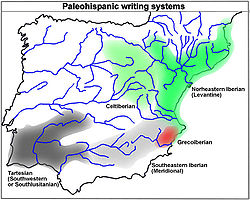
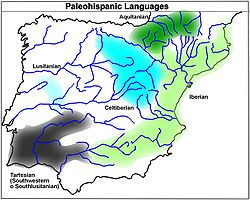
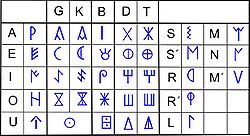
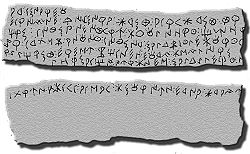
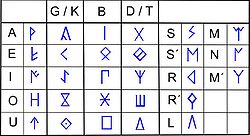
.jpg)
.jpg)
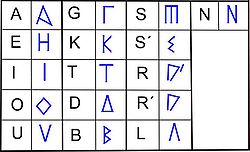
.jpg)
Paleohispanic scripts
The Paleohispanic scripts are the writing systems created in the Iberian peninsula before the Latin alphabet became the dominant script...
that were used to represent the extinct Iberian language
Iberian language
The Iberian language was the language of a people identified by Greek and Roman sources who lived in the eastern and southeastern regions of the Iberian peninsula. The ancient Iberians can be identified as a rather nebulous local culture between the 7th and 1st century BC...
. Most of them are typologically very unusual in that they are semi-syllabic
Semi-syllabary
A semi-syllabary is a writing system that behaves partly as an alphabet and partly as a syllabary. The term has traditionally been extended to abugidas, but for the purposes of this article it will be restricted to scripts where some letters are alphabetic and others are syllabic.-Iberian...
rather than purely alphabetic. The oldest Iberian inscriptions date to the 4th or possibly the 5th century BCE, and the latest from end of the 1st century BCE or possibly the beginning of the 1st century CE.
Variants
There are two main graphic as well as geographic variants in the family:- Northeastern Iberian scriptNortheastern Iberian scriptThe northeastern Iberian script is also known as Levantine Iberian or Iberian, because it is the Iberian script that was most frequently used, and was the main means of written expression of the Iberian language. The language is also expressed by the southeastern Iberian script and by the...
- Dual variant (4th century BCE and 3rd century BCE) (tentative)
- Non-dual variant (2nd century BCE and 1st century BCE)
- Southeastern Iberian scriptSoutheastern Iberian scriptThe southeastern Iberian script, also known as Meridional Iberian, was one of the means of written expression of the Iberian language, which was written mainly in the northeastern Iberian script and residually by the Greco-Iberian alphabet...
In the sense that the Iberian scripts are the scripts created for the Iberians to represent the Iberian language, the Greco-Iberian alphabet
Greco-Iberian alphabet
The Greco-Iberian alphabet is a direct adaptation of an Ionic variant of a Greek alphabet to the specifics of the Iberian language, thus this script is an alphabet and lacks the distinctive characteristic of the rest of paleohispanic scripts that present signs with syllabic value, for the...
, a separate adaptation of the Greek alphabet
Greek alphabet
The Greek alphabet is the script that has been used to write the Greek language since at least 730 BC . The alphabet in its classical and modern form consists of 24 letters ordered in sequence from alpha to omega...
, was also an Iberian script. It was used mainly in Alicante
Alicante
Alicante or Alacant is a city in Spain, the capital of the province of Alicante and of the comarca of Alacantí, in the south of the Valencian Community. It is also a historic Mediterranean port. The population of the city of Alicante proper was 334,418, estimated , ranking as the second-largest...
and Murcia
Murcia
-History:It is widely believed that Murcia's name is derived from the Latin words of Myrtea or Murtea, meaning land of Myrtle , although it may also be a derivation of the word Murtia, which would mean Murtius Village...
. Likewise, neither the southwestern script, very similar to southeastern Iberian script but used for the Tartessian language
Tartessian language
The Tartessian language is the extinct Paleohispanic language of inscriptions in the Southwestern script found in the southwest of the Iberian Peninsula: mainly in the south of Portugal , but also in Spain . There are 95 of these inscriptions with the longest having 82 readable signs...
, nor the Celtiberian script
Celtiberian script
The Celtiberian script is a paleohispanic script that was the main means of written expression of the Celtiberian language, an extinct Continental Celtic language, also expressed in Latin alphabet...
, a direct adaptation of the northeastern Iberian script
Northeastern Iberian script
The northeastern Iberian script is also known as Levantine Iberian or Iberian, because it is the Iberian script that was most frequently used, and was the main means of written expression of the Iberian language. The language is also expressed by the southeastern Iberian script and by the...
used for the Celtiberian language
Celtiberian language
Celtiberian is an extinct Indo-European language of the Celtic branch spoken by the Celtiberians in an area of the Iberian Peninsula lyingbetween the headwaters of the Duero, Tajo, Júcar and Turia rivers and the Ebro river...
, are technically Iberian scripts.
The northeastern Iberian script is often known simply as the Iberian script, because it is the script of 95% of known Iberian inscriptions. These have been found mainly in the northeastern quadrant of the Iberian Peninsula
Iberian Peninsula
The Iberian Peninsula , sometimes called Iberia, is located in the extreme southwest of Europe and includes the modern-day sovereign states of Spain, Portugal and Andorra, as well as the British Overseas Territory of Gibraltar...
, mostly along the coast from Languedoc-Roussillon
Languedoc-Roussillon
Languedoc-Roussillon is one of the 27 regions of France. It comprises five departments, and borders the other French regions of Provence-Alpes-Côte d'Azur, Rhône-Alpes, Auvergne, Midi-Pyrénées on the one side, and Spain, Andorra and the Mediterranean sea on the other side.-Geography:The region is...
to Alicante
Alicante
Alicante or Alacant is a city in Spain, the capital of the province of Alicante and of the comarca of Alacantí, in the south of the Valencian Community. It is also a historic Mediterranean port. The population of the city of Alicante proper was 334,418, estimated , ranking as the second-largest...
, but with a deep penetration on the Ebre valley.
The southeastern Iberian script is poorly attested, and there are some gaps in the records: There are no positively identified symbols for /gu/, /do/, and /m/, for example. Unlike the northeastern Iberian script
Northeastern Iberian script
The northeastern Iberian script is also known as Levantine Iberian or Iberian, because it is the Iberian script that was most frequently used, and was the main means of written expression of the Iberian language. The language is also expressed by the southeastern Iberian script and by the...
the decipherment of the southeastern Iberian script is not still closed, because there are a significant group of signs without consensus value. The southeastern inscriptions have been found mainly in the southeastern quadrant of Iberia: Eastern Andalusia
Andalusia
Andalusia is the most populous and the second largest in area of the autonomous communities of Spain. The Andalusian autonomous community is officially recognised as a nationality of Spain. The territory is divided into eight provinces: Huelva, Seville, Cádiz, Córdoba, Málaga, Jaén, Granada and...
, Murcia
Murcia
-History:It is widely believed that Murcia's name is derived from the Latin words of Myrtea or Murtea, meaning land of Myrtle , although it may also be a derivation of the word Murtia, which would mean Murtius Village...
, Albacete
Albacete
Albacete is a city and municipality in southeastern Spain, 258 km southeast of Madrid, the capital of the province of Albacete in the autonomous community of Castile-La Mancha. The municipality had a population of c. 169,700 in 2009....
, Alicante
Alicante
Alicante or Alacant is a city in Spain, the capital of the province of Alicante and of the comarca of Alacantí, in the south of the Valencian Community. It is also a historic Mediterranean port. The population of the city of Alicante proper was 334,418, estimated , ranking as the second-largest...
, and Valencia.
There is substantial graphic variation in the Iberian glyphs, and over the past several decades many scholars have come to believe that, at least in northeastern Iberian script (and recently also in Celtiberian script) some of this variation is meaningful. It appears that the original simple letters were assigned specifically to the voiced consonants /b/, /d/, /g/, whereas the voiceless consonants /t/ and /k/ were derived from /d/ and /g/ syllables with the addition of a stroke. (This is the so-called dual signary model: see the image at right). If correct, this innovation would parallel the creation of the Latin letter G from C by the addition of a stroke.
Typology
Excepting the Greco-Iberian alphabetGreco-Iberian alphabet
The Greco-Iberian alphabet is a direct adaptation of an Ionic variant of a Greek alphabet to the specifics of the Iberian language, thus this script is an alphabet and lacks the distinctive characteristic of the rest of paleohispanic scripts that present signs with syllabic value, for the...
, the Iberian scripts are typologically unusual, in that they were partially alphabetic and partially syllabic
Syllabary
A syllabary is a set of written symbols that represent syllables, which make up words. In a syllabary, there is no systematic similarity between the symbols which represent syllables with the same consonant or vowel...
: Continuants (fricative
Fricative consonant
Fricatives are consonants produced by forcing air through a narrow channel made by placing two articulators close together. These may be the lower lip against the upper teeth, in the case of ; the back of the tongue against the soft palate, in the case of German , the final consonant of Bach; or...
sounds like /s/ and sonorant
Sonorant
In phonetics and phonology, a sonorant is a speech sound that is produced without turbulent airflow in the vocal tract; fricatives and plosives are not sonorants. Vowels are sonorants, as are consonants like and . Other consonants, like or , restrict the airflow enough to cause turbulence, and...
s like /l/, /m/, and vowels) were written with distinct letters, as in Phoenician (or in Greek in the case of the vowels), but the non-continuants (the stops
Stop consonant
In phonetics, a plosive, also known as an occlusive or an oral stop, is a stop consonant in which the vocal tract is blocked so that all airflow ceases. The occlusion may be done with the tongue , lips , and &...
/b/, /d/, /t/, /g/, and /k/) were written with syllabic glyphs that represented both consonant and vowel together. That is, in written Iberian, ga displayed no resemblance to ge, and bi had no connection to bo. This possibly unique writing system is called a "semi-syllabary
Semi-syllabary
A semi-syllabary is a writing system that behaves partly as an alphabet and partly as a syllabary. The term has traditionally been extended to abugidas, but for the purposes of this article it will be restricted to scripts where some letters are alphabetic and others are syllabic.-Iberian...
".
The southeastern script was written right to left, as was the Phoenician alphabet
Phoenician alphabet
The Phoenician alphabet, called by convention the Proto-Canaanite alphabet for inscriptions older than around 1050 BC, was a non-pictographic consonantal alphabet, or abjad. It was used for the writing of Phoenician, a Northern Semitic language, used by the civilization of Phoenicia...
, whereas the northeastern script reversed this to left to right, as in the Greek alphabet
Greek alphabet
The Greek alphabet is the script that has been used to write the Greek language since at least 730 BC . The alphabet in its classical and modern form consists of 24 letters ordered in sequence from alpha to omega...
.
Origins
The relation between the northeastern and southeastern Iberian scripts is not straightforward. It appears that either the glyphs themselves were changed, or that they assumed new values. For example, southern /e/ derives from Phoenician/Greek Ο (‘ayin), whereas northern /e/ resembles Phoenician/Greek Ε (he), a letter which arguably had the value of /be/ in southern Iberian. However, it is clear that they had a common origin, and the most commonly accepted hypothesis is that the northeastern script derives from the southeastern script. Some researchers conclude that their origin ultimately lies solely with the Phoenician alphabet, while others believe the Greek alphabet also played a role.See also
- Iberian languageIberian languageThe Iberian language was the language of a people identified by Greek and Roman sources who lived in the eastern and southeastern regions of the Iberian peninsula. The ancient Iberians can be identified as a rather nebulous local culture between the 7th and 1st century BC...
- Paleohispanic scriptsPaleohispanic scriptsThe Paleohispanic scripts are the writing systems created in the Iberian peninsula before the Latin alphabet became the dominant script...
- Pre-Roman peoples of the Iberian PeninsulaPre-Roman peoples of the Iberian PeninsulaThis is a list of the Pre-Roman peoples of the Iberian peninsula .-Non-Indo-European:*Aquitanians**Aquitani**Autrigones - some consider them Celtic .**Caristii - some consider them Celtic ....
Further reading
- Correa, José Antonio (2004): , ELEA 4, pp. 75–98.
- Correa, José Antonio (1992): , AIΩN 14, pp. 253–292.
- Ferrer i Jané, Joan (2005) Novetats sobre el sistema dual de diferenciació gràfica de les oclusives sordes i sonores, Palaeohispanica 5, pp. 957–982.
- Gómez-Moreno, Manuel (1922): , 9, pp. 34–66.
- Hoz, Javier de (1987): , Veleia 2-3, pp. 285–298.
- Hoz, Javier de (1985): , pp. 443–453.
- Maluquer de Motes, Joan (1968): , Barcelona.
- Quintanilla, Alberto (1993): , pp. 239–250.
- Rodríguez Ramos, Jesús (2004): , Vitoria-Gasteiz 2004, ISBN 84-8373-678-0.
- Rodríguez Ramos, Jesús (2002): , Zephyrus 55, pp. 231–245.
- Untermann, JürgenJürgen UntermannJürgen Untermann is a German linguist, indoeuropeanist and epigraphist.A disciple of Hans Krahe and of Ulrich Schmoll, he studied at the University of Frankfurt and the University of Tübingen...
: Monumenta Linguarum Hispanicarum, Wiesbaden. (1975): I Die Münzlegenden. (1980): II Die iberischen Inschriften aus Sudfrankreicht. (1990): . (1997): . - Velaza, Javier (2004): , Madrid, pp. 95–114.
- Velaza, Javier (1996): , Barcelona.
External links
- Los primeros sistemas de escritura en la Península Ibérica (Course program)
- Ancient Scripts - Iberia
- Levantine Iberian Script
- Meridional Iberian Script
- Greek Iberian Script
- Celtiberian Script
- Tartessian / South-Lusitanian Script
- "On the Story of the Decipherment of Iberian Writing" by Jesús Rodríguez Ramos
- Omniglot entry on Iberian
- Detailed map of the Pre-Roman Peoples of Iberia (around 200 BCE)
- Links to images of inscriptions

